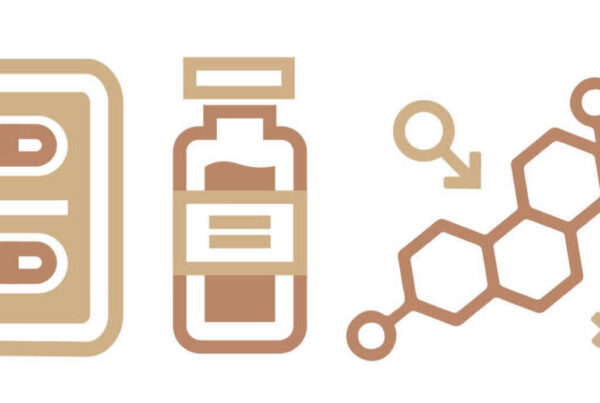 Estrogen is not just one of the main hormones responsible for women’s ability to have children, but it also contributes to their overall health. Estrogen specifically estradiol helps protect the heart, the bones and the brain.
Estrogen is not just one of the main hormones responsible for women’s ability to have children, but it also contributes to their overall health. Estrogen specifically estradiol helps protect the heart, the bones and the brain.
Read this article to learn about:
- Optimal estrogen levels
- How Bio-Identical estrongen helps
- How to take estrogen
- Why you must consult a professional
What Are Optimal Levels?
During their fertile years, the level of estrogen in a woman’s bloodstream goes through cycles, sometimes falling as low as 40 or 50 pg/mL and rising as high as 800 pg/ml. This ebb and flow is particularly important for a woman’s fertility and responsible for women having periods.
Falling estrogen levels during the period of time around the beginning of menopause – also known as perimenopause – produces the symptoms commonly associated with this transition, such as hot flashes and night sweats. It also makes women more susceptible to heart disease, Alzheimer’s Disease and osteoporosis. For post-menopausal women, the level of estrogen, typically, will drop down below 15 pg/ml. Bioidentical Hormone Replacement Therapy brings estrogen levels back up to their optimal range, about 75 to 100 pg/ml, alleviating perimenopasual symptoms and reducing the risk of disease.
How Bioidentical Estrogen Helps
Bioidentical Estrogen is actually a classification of hormone that includes: estrone, estriol and estradiol. Estradiol is the main estrogen component involved in fertility, and the safest and healthiest of the group for replacement therapy. Estradiol can help to alleviate:
- Hot flashes
- Night sweats
- Vaginal dryness
- Memory fog
- Sleep disturbance
- Irritability
- Incontinence
- Headaches and Migraines
Estradiol replacement also prevents osteoporosis by inhibiting the cells that break down bone. It also helps increase good cholesterol – HDL – which is the main cholesterol that helps reduce the risk of heart disease. Lastly, estradiol has been shown to prevent Alzheimer’s disease especially if it initiated early enough.
How to Take Estrogen: A Variety of Factors at Play
There are two main ways to take estrogen: orally and topically. The right method depends on your age, time out of menopause and risk factors for heart disease.
Oral estradiol is typically suitable for women who are*:
- Under the age of 60
- Less than 10 years out of menopause
- Not at risk for heart disease
Oral estradiol has a complex relationship with heart disease. For women who meet the above criteria, oral estrogen reduces their risk of heart disease by 50 percent.
However, when estradiol goes through the liver, it increases the levels of matrix metalloporteinases (MMPs). If a woman has plaques in her arteries, MMPs can rupture them, potentially causing a heart attack. The risk of heart attack for women with heart disease risk factors particulary hypertension greatly increases during their first year of taking oral estradiol. After the one-year mark, it does drop back to down to women who have no risk factor of heart disease – 50%. This is why it is so important to consult with a medical doctor specializing in bioidentical hormones before beginning a treatment regime.
Taking estradiol orally has the added benefit of reducing your risk of Alzheimer’s disease. When estradiol passes through the liver, it causes the production of HDL, the good kind of cholesterol, associated with this health benefit.
Estradiol cream is a superior and much safer option for women who are*:
- Over the age of 60 and have not taking estrogen replacement in the past
- More than 10 years out of menopause without taking estrogen
- Exhibiting heart disease risk factors particularly hypertension.
The cream does not pass through the liver, and therefore does not increase the level of MMPs. It has many of the same benefits of oral estradiol, including the alleviation of perimenopausal symptoms and prevention of osteoporosis. Currently, however, there is no evidence that it decreases the risk of heart disease or Alzheimer’s disease although there are studies to evaluate this possibility being conducted as we speak.
There’s No One Size Fits All Treatment
Lifestyle also influences the decision to take oral or topical estrogen. For women who remain active well into their 60s, who exercise on a regular basis and eat well, oral estradiol may still be an option. Women who take Premarin, a synthetic estrogen, can typically transition to oral estradiol without increasing their risk of heart disease.
Because of the complex relationship between estradiol administration and heart disease, it is imperative to talk to a physician about the options best suited to you. When properly administered, estrogen replacement therapy is a safe and effective way to relieve perimenopausal symptoms and prevent disease.
*Always consult with a medical doctor before beginning any treatment plan
Academic Sources
- VT Miller, J LaRosa, et al. Effects of Estrogen or Estrogen/Progestin Regimens on Heart Disease Risk Factors in Postmenopausal Women: PEPI Trial. JAMA. 1995;273 (3): 199-208
- Grodstein F, Stampfer M. Estrogen for women at varying risk of coronary disease. Maturitas. 1998;30:19–26.
- Grodstein F, Manson JE, Colditz GA, Willett WC, Speizer FE, Stampfer MJ. A prospective observational study of postmenopausal hormone therapy and primary prevention of cardiovascular disease. Ann Intern Med 2000; 133:933-941.
- JAMA. Feb 28, 2001; Volume 28(8). page 995
- Nurse’s Health Study. Hippocrates. 12/2000. 288
- Circulation, 1999: 100: 2319 – 2325
- HN Hodis, Postmenopausal Hormone Therapy and Cardiovascular Disease. Clin Obstet Gynecol. 2008 September; 51(3): 564–580.





